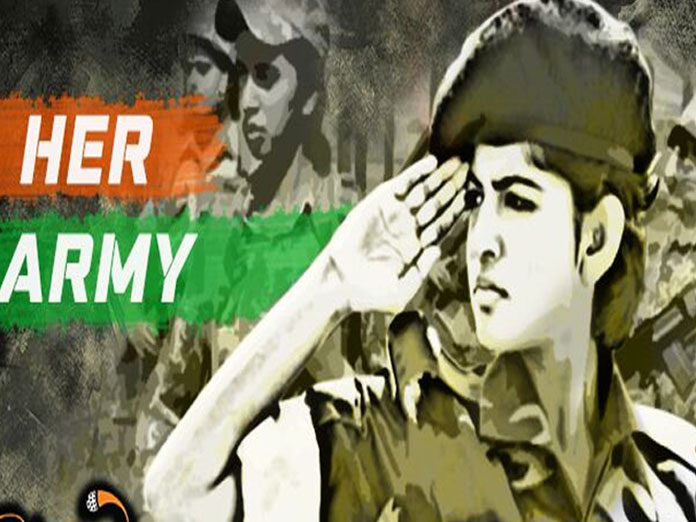Live
- TTD EO visits Sringeri Sarada Peetham
- Automobile loading using NMG rakes commences
- 555th Prakash Purab celebrated with gaiety
- Good news for Atmakur farmers
- High-risk aortic valve replacement surgery performed successfully
- HMWSSB MD holds review meeting on OTS-2024 scheme
- Dhobi Ghat assessed for potential to host sports complex
- SCR bets on LHB train coaches for safety
- SVU felicitates best teachers
- Tata Group to market Araku coffee
Just In

The recent announcement by Defence Minister Nirmala Sitharaman to recruit 20 per cent women in the corpse of military police comes as a positive step towards women empowerment and will be a morale booster to women wanting to join armed forcesAs of now, the Indian Army has 380 of its work force as women, the Air Force has 1309 and the Navy 6 per cent The women are recruited in defence only i
The recent announcement by Defence Minister Nirmala Sitharaman to recruit 20 per cent women in the corpse of military police comes as a positive step towards women empowerment and will be a morale booster to women wanting to join armed forces.As of now, the Indian Army has 3.80 % of its work force as women, the Air Force has 13.09% and the Navy 6 per cent. The women are recruited in defence only in the officer's rank. They are not allowed as combatants in the specialist forces, such as “Ghatak”, “Garud”, MARCOS, para-commandos, etc.
Women's role in the Indian army can be traced back to 1888 when the ‘Indian Military Nursing Service’ was formed during British Raj. From 1914 to 1945, Indian Army nurses served in the First and Second World Wars and as per records, 350 nurses died, taken prisoners or declared missing in action. It was only in 1992 the Indian army decided to induct women to serve in the Infantry, the Armoured Corps and Mechanised Infantry.
Breaking yet another glass ceiling, a special contingent of about 500 women CRPF personnel was deployed in Kashmir valley for regular security duties and to tackle the unruly crowds and stone-pelters, in July last. They were largely in constable ranks. A few years back, the CRPF women troops were inducted into the anti-naxal operations grid in Chhattisgarh and Jharkhand.
Some time back, Union Home Minister Rajnath Singh had announced that 33 per cent women would be recruited in constable ranks in CRPF and Central Industrial Security Force (CISF) and 15 per cent women will be recruited in Border Security Force (BSF), Sahastra Seema Bal (SSB) and Indo-Tibetan Border Police (ITBP).In keeping with changing trend, IPS officer Sonali Mishra became the first woman to be posted as the frontier commander of Kashmir by BSF in June 2017, while a 25-year-old Prakriti from Bihar became the first direct-entry combat officer in the ITBP in March last year.
Now many States like Maharashtra have 33 per cent reservation for women in prison administration and they are assigned duties in male prisons too.In other countries, number of women serving in defence forces is relatively high. The women serve in 91% of all army occupations and make up about 14% of the active army in USA. Although they cannot serve with ground units that engage in direct combat, they are allowed to fly combat aircraft and serve on combat ships. Participation of women in defence forces in some of the countries is: Canada- 15 %, Australia: 18.5%, and France: 8.55%.
The countries like Denmark, Estonia, Finland, France, Germany, Lithuania, Netherlands, Norway, Poland, Romania, Australia, Canada, New Zealand, Eritrea, Israel and North Korea allow women in front-line combat positions. Whereas Pakistan, Serbia, South Africa, South Korea, the UK and USA allow women in positions such as fighter pilots.In the last few years, Indian women have outsmarted men in sports. In the last Asian Games Vinesh Phogat (wrestling), Rahi Sarnobat (shooting) and Swapna Barman (heptathlon) proved their mettle.
Mary Kom, made the country proud when she chose the unconventional sport “boxing”. P V Sindhu has become India’s first medallist in women’s singles at the Badminton World Championships, and Badminton champ Saina Mehwal won over 24 international titles.It may be recalled that Bachendri Pal had become the first Indian woman to climb the Everest way back in 1984 followed by many adventurous and ambitious girls. In these circumstances there is no reason why we should shy away from the combat role for women.
Ironically the Women's Reservation Bill or The Constitution (108th Amendment) Bill, 2008 which seeks to reserve 33.33 per cent seats for women in the Lok Sabha and in the State Legislative Assemblies, is yet to be passed. It was passed by the Rajya Sabha, on 9th March 2010 amidst stiff resistance from some political parties. But it is yet to be tabled in the Lok Sabha.
Raju Vernekar, Mumbai

© 2024 Hyderabad Media House Limited/The Hans India. All rights reserved. Powered by hocalwire.com







